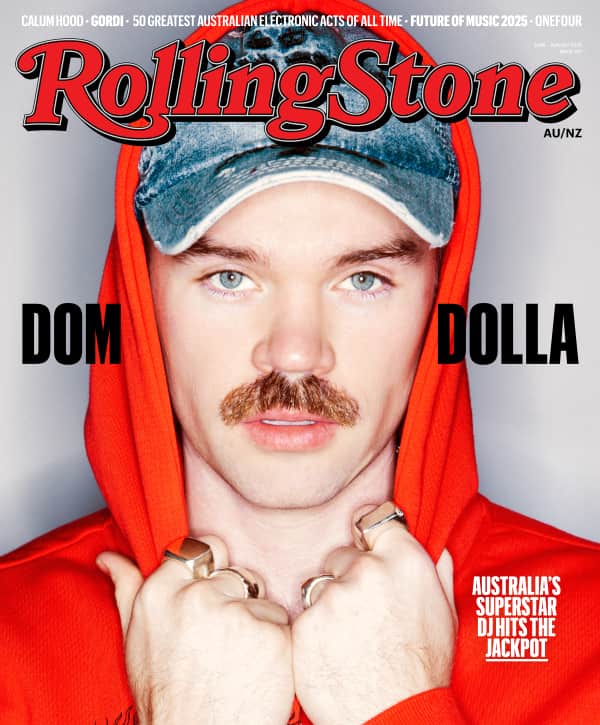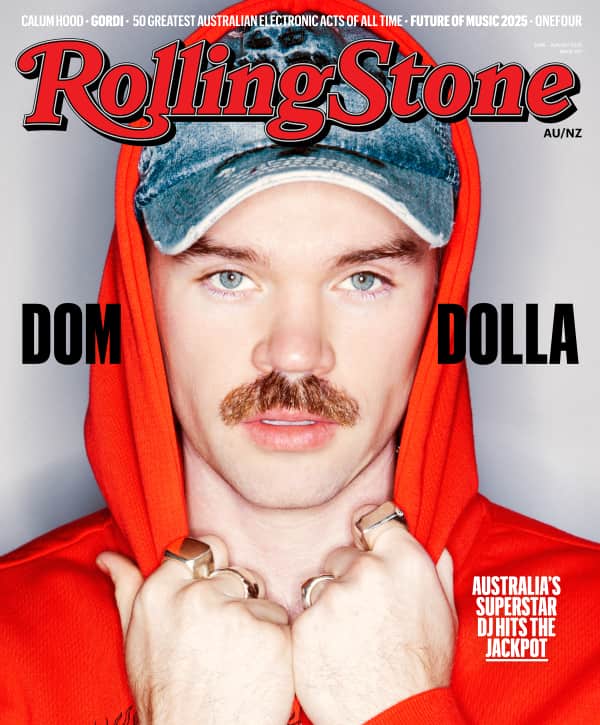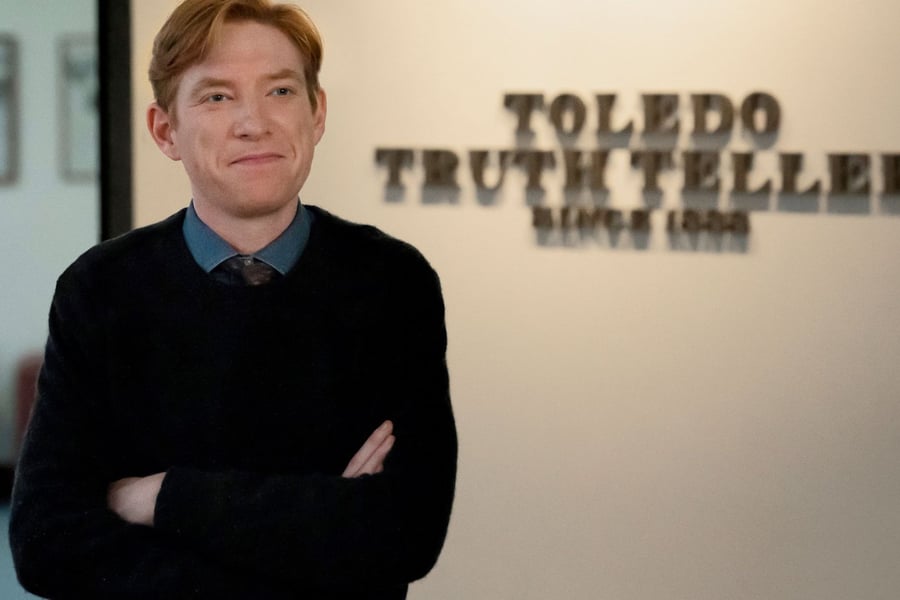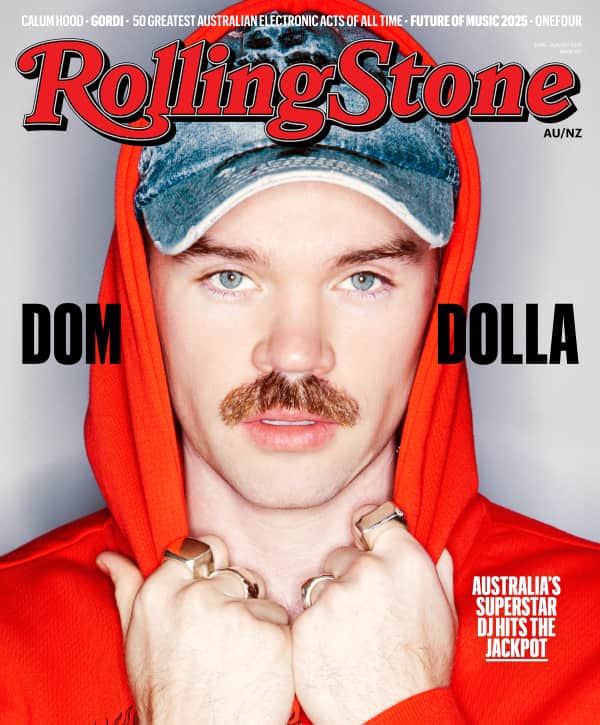It would have been easy for Greg Daniels, who adapted The Office for American audiences to wild success, to revive the beloved series by hiring a cast of returning faces or bringing its mockumentary cameras back to the Scranton, Pennsylvania, paper company Dunder Mifflin. Instead, to some people’s surprise, he and The Paper co-creator Michael Koman shifted their focus to a Toledo, Ohio, newspaper and brought in an almost entirely new group of actors, establishing the series as a spinoff rather than a sequel. The 10-episode first season, which debuted on Peacock on Sept. 4, centers on the Toledo Truth Teller, a once-great newspaper now owned by the same paper conglomerate that has also absorbed Dunder Mifflin. The connective tissue is the documentary crew from The Office, searching for its next subject.
The Toledo Truth Teller gets a boost from the arrival of Ned Sampson (Domhnall Gleeson), a bright-eyed former salesman who is assuming the role of editor-in-chief. He’s up against a lot of hurdles: no budget, a meager and untrained staff, and a managing editor, Esmeralda Grand (Sabrina Impacciatore), who wants to sabotage his every move. But over the course of the season, Ned convinces his team of misfits that actual reporting is the way to success — leading eventually to three nominations at the local journalism awards. The show is ultimately about how a passion for the job can be exactly what you need to turn things around.
“This is not a group of people who are suffering through their day at work and looking for other outlets for happiness,” Koman says of comparisons to The Office. “It’s a kind of work where hopefully they’re finding something about the work itself that brings them some satisfaction and some joy.”
The choice to shine a light on journalism, particularly of the local variety, is especially poignant during a moment when the Fourth Estate is being diminished by macroeconomic forces and even attacked by political ones. The Paper emphasizes how essential — and sometimes even heroic — local journalism can be, something that was intentional for the co-creators.
“Sometimes you have a work situation where you can’t wait to get home and it’s just a job and it’s a paycheck, and other times you have work where you’re actually super excited about what you’re doing,” Daniels says. “Either because the boss is inspiring or the work is inspiring, but you find yourself staying late and being excited about work. That’s rare. It’s wonderful if people have it. I feel like people in journalism have it, because it’s a bit of a calling.”
Here, Daniels and Koman discuss why they set The Paper in the world of media, how it differs from The Office, and how they convinced Oscar Nunez to return as sarcastic accountant Oscar Martinez.
You could have set The Paper in any number of industries. Why a local newspaper?
Daniels: The main connective tissue with the old show is the documentary crew. It’s not just a style — we really believe that the documentary crew is in the room holding the cameras and that they’re there for a purpose, and that the same crew is exploring changing workplaces. At Dunder Mifflin [it was about] behavior in the workplace and what’s appropriate. That was the theme of the first show, so now they’re looking for a new topic. And the hollowing-out of local journalism is a very important topic. It seems like something that the documentary crew would be excited by. And to see a very optimistic person come in and try to turn it around seems like a really cool story. Parks and Recreation is about government; journalism is its own sphere that has its own ethics and history and tropes.
Love Music?
Get your daily dose of everything happening in Australian/New Zealand music and globally.
Koman: The main thing to me is: Do you believe that a documentary crew would stop and really say, “Wait a second, this seems like an interesting enough story.” And I do believe that this subject is interesting enough. The state of modern journalism [and] print journalism right now is a natural subject for a real documentary. Anyone making the effort to take a print paper and try to bring it up in popularity is worthwhile, both as a documentary subject and as a story.
Daniels: The Office had a tone that included some poignancy and a bit of nostalgia. Ordinary people trying to be decent. The idea that this very historic newspaper that’s declined and the ordinary people who work there are going to take a run at restoring it — there is something about it that seems to hit the same emotional tone.
Have either of you ever worked in journalism?
Daniels: I worked at my college newspaper.
Koman: For me, it was my high school newspaper.
Do you remember the names of the papers?
Daniels: Mine was The [Harvard] Crimson. I was basically reviewing TV. I wrote articles about The A-Team. I was an early proponent of The A-Team when it came out. And Miami Vice. That was the era.
Koman: My high-school paper was called The Palette. I have no idea what the name meant. We also didn’t have a logo, which might have helped to explain it.
Daniels: I also worked for Voice of America as a stringer one summer, which was radio journalism, which was also interesting.
As you were conceiving the Toledo Truth Teller, what sort of research did you do into local journalism?
Daniels: We based it on a number of different papers. I was doing King of the Hill right before this, and as part of that I went to Dallas and had a session with The Dallas [Morning] News, with a lot of their reporters. We did research on Toledo newspapers and other Ohio newspapers.
Koman: A lot of it was through reading. There were very helpful reporters who would talk to us. I tried to learn as much as I could just through reading a lot of small papers. I would just look up towns and then “newspaper” and then start following that newspaper. I still follow quite a few of them. You can see when a paper has been acquired by a large news service that owns many newspapers and maybe the staff there has been reduced and they’re running wire stories. Other papers have held on to a staff and you could tell the difference in the quality of the local news between the two of them and how focused they were on local stories. And it’s journalism, so fortunately a lot of people in that field have written books about it.
Daniels: There’s a lot of good stories about “When I was a cub reporter and the mistakes that I made” and stuff like that.
Koman: They tend to tell very similar arcs where people obviously really enjoyed their twenties when they got into it and then this slog starts to happen. But the stories become bigger and the achievements become bigger. There’s a lot of nostalgia that happens when people get into journalism from the bottom and the fun of working their way up.
Is the look of the newspaper office based on a real office?
Daniels: Susie Mancini, our production designer, did a ton of research. A lot of it was what people’s expectations are. For instance, the columns and the desk placement: If you remember All the President’s Men and that sense of how long the room is. Our set is actually quite enormous. The Truth Teller building is a nine-story, ornate 1920s building downtown, and the newspaper is now on half of the ninth floor and the other half is a toilet paper sales office. They gradually had to give up floor after floor, as they were being defunded by this conglomerate. We shot a documentary inside the documentary in 1971 of what the newspaper looked at the height, so that’s another poignant aspect of it. Now, they’re half a floor in their original building.
Koman: When we first talked about it, the idea was to work backwards from a lot of images of 1960s newsrooms and that period of time. And then imagining that’s been subdivided into a place where now two or three businesses are working together. What would happen if you started to minimize the amount of space that was given over to the newspaper?
Has working on the show impacted how you feel about local journalism?
Daniels: I don’t think we’re experts in the business of journalism. What we’re trying to do is remind people of the glorious past and the valuable contribution of newspapers and make them feel that it’s something worth defending. That the struggle of these underdogs is something they’ll emotionally connect to. Ned is very romantic about journalism, very optimistic, and he’s really decided that original reporting is the answer for the local news. That there’s no point in just passing along stories that you can get anywhere online. I believe that. I believe that is a value — that communities need to have local news covering them. I don’t know if that’s a good economic model. I’m sure that’s a panacea, that if you just really double down on local news it’ll all work out. But it’s a good goal for him.
It’s very genuine how much Ned believes in local news.
Daniels: Yeah. Let’s hope it’s a spark of something that can be transmitted.
As you conceived the characters for The Paper, did you ever want to echo any of the beloved characters from The Office? Or are these all original?
Daniels: We 100 percent wanted them to be brand new characters. There were 16 series regulars on The Office, and the style we’re working in is very observational. So you’re really trying to not just come up with a completely weird, kooky character who doesn’t exist. You’re trying to root it in types of people you might have run into.
Koman: I tried to keep it completely out of my mind. When we would talk, I would not think about the fact that it was even connected to another show as much as possible. And if something came up, if there was a detail that felt like it was drifting too far into that world, you would try to maneuver back. Like, “OK, well, what else can we do?” Obviously, I cannot blame anyone for watching this show and looking for comparisons and looking for similarities. But I can say there’s no intention to do anything other than create something that was its own thing and create characters that felt new to us. It’s a workplace. There are only so many types of human beings. You’re going to find qualities that people share, but the goal was always originality.
Daniels: When I was doing The Office, I often was very concerned with three-dimensionalizing the characters, which takes time. Because you first learn their primary characteristic, and then you learn, for instance, Dwight is very authoritarian, but he also really loves anime and he’s a farmer. You don’t get to put all of that in the first time you meet him because it would be crazy and schizophrenic. You’re introducing pieces of the character and deeper into the series you’re like, “Oh, those guys are really interesting because they have all these aspects to them.” When people look at the very first episode of a new series they don’t necessarily see all of the three-dimensionality we’ve built into the characters. So they may glom onto one thing and go, “Oh, look at that guy. He’s tall and thin. He must be Jim Halpert.” But people are complicated and we have an entire backstory and all these weird quirks about this character that you’ll learn if you sit with the show a bit. You’ll see that they’re all different.
Koman: In our mind, the biggest crossover character was the documentary crew. They’re coming in and the style is familiar. That, to me, is what carries over the most. Other than, obviously, Oscar.
At what point did you know Oscar would be part of this story?
Daniels: I talked to Oscar years ago. I first pitched this in 2017. The Office was really big on Netflix. It was the number one show on Netflix from 2016 to 2020, I think. At the time, there was a lot of pressure [for a spinoff], but I couldn’t do it yet because I was running a show called Upload for Amazon. But I didn’t want them to start thinking about someone else to come be brought in. So I planted my flag saying, “This is going to be about journalism, and Oscar is going to be the character.” I met with Oscar and said to him, “Tell me if you’re about to take something that would interfere with this because maybe we’ll come up with some kind of holding deal.” But I always thought that Oscar was the right character. Because so many of the other Office characters in the finale had a closure to their character arcs. They were going into different fields and they were going to different cities. Oscar still worked at Dunder Mifflin and didn’t have an enormous change in who he was.
Are you going to release the game he creates for the Truth Teller?
Koman: I don’t think we really know the rules of it. But yeah, that’s a really good goal. We should figure out the rules.
Did you feel any pressure to include more ties to The Office or bring back other characters?Daniels: Would you respect us if we were constantly dipping in and out and using old characters as guest stars as crutches? I don’t think anybody would. We had a couple of times when it was appropriate to make reference and The Office fans have responded very nicely to those.
Koman: It was really important to have our own [thing]. If you’re trying to have pride in your work and you’re trying to tell a story that works and that people care about it, [you can’t be] preoccupied with little stunts. You’re trying to hopefully create something that is worth caring about. So I don’t think that using something that found a place in people’s hearts because of its own hard work really should be used when you’re trying to create something that you want people to value of its own merit.
How many seasons of The Paper did you map out?
Daniels: [We started the show] based on my experience doing Parks and Recreation, which also had an order for a season, as opposed to my experience doing The Office, where we just had an order for a pilot. We were able to do the pilot, and then a year later do the first season. You learn so much when you know who the cast is, which always happens after the pilot’s written. So I had it in our deal [for The Paper] that we would take a month off after shooting the pilot so that we could edit it and examine it and learn from it. We really front-loaded all of our effort in getting the pilot right, and then we settled into it. We had a lot of great story ideas, but they did change a lot based on table readings after we had started to work with the cast and understood their strengths.
What’s an example of a character who changed based on the actor’s performance in the pilot?
Daniels: Boy, I feel like we shifted all of them. But Domhnall came in and had a lot of quirky suggestions for his character. For me at least, I was like, “Huh, I don’t know if everyone’s going to respect this character after he’s this weird.” But then it turned out to be great. He has the ability to really play this leadership energy and this very winning kind of energy, despite a lot of quirky, weird behaviors that you would think would diminish him as a leader.
Koman: He’s one of those actors who can convince you that what he’s doing is real. Even when you go to sit down to write after seeing him perform the character, that’s what’s in your head. You do start writing Ned in that voice.
Daniels: Just the way he runs down a hallway. Like he deliberately runs in a way that makes the other characters think, “I want to respect him, but it’s very hard to admire that man.”
I imagine Sabrina also brought a lot to Esmeralda.
Daniels: She was amazing. [Michael and I] kept texting each other during her audition because it was over Zoom, and we were really blown away. It really felt like she was the character. She brings an insane amount of energy and physical comedy and likability to the character.
The first season ends with a cliffhanger. How did you navigate how much to leave the audience wondering about and how much to resolve?
Daniels: It’s a 10-episode streaming season that will have probably about a year in between seasons. It’s a style of storytelling that I think benefits from cliffhangers, so that the audience has something to wonder about while they are waiting through the long winter to get to their next season. So there are certain instincts about how to tell the story in this format that probably informed the last episode.
Did you know all of the episodes would drop at once while you were writing it?
Koman: I don’t think when we were writing those episodes. We were probably into editing before there was a real thought about how the audience would see this and how long you’d have to wait between the episodes.
Daniels: There were really two possibilities. We originally were going to do four episodes, then two, two, and two, and spread it out over a month. Part of the thinking was that the original Office dropped more slowly and you had time to wonder about things. But Peacock pointed out to us that the majority of the audience has been seeing it on streaming, not on the original NBC run. The number of people who saw it on Netflix and Peacock has dwarfed the original way it was released.
Koman: I used to be very much of a purist, like I liked the way television worked and I liked that you watched a show at 8 p.m. on Thursday. But now, I like to be able to watch all of something in a week. I don’t want to have this delay period put in if it’s not necessary. One of the big advantages of the way television seasons used to air was that it would be one episode a week, but the writers were still writing during that season. So you can make decisions as the season was unfolding. It wasn’t set in stone. In this case of these shows, whether it comes out once a week or not, you’re pretty much done.
In the spirit of the Truth Teller, what newspapers do you each regularly read?
Daniels: I find that you have to read a bunch. One of the things we learned and one of the things that Ned is maybe naively pushing against, is that in the history of journalism people started questioning what objectivity means. That has been thrown out the window. It’s not even a goal. So many of the places you could get news have just decided to go in a certain direction. A lot of the journalists we talked to [said] they feel trapped by their readers in a way. That they’re constrained about what kinds of stories that they can write because of the expectations of the readership. So it’s really interesting to watch how different news sources cover the same events with certain attempts to pander to their readership. I generally read about five different ones.
Koman: The more newspapers you read, the more you realize that once you go to two, you want to go to five. Because every point of view makes you feel like you’re getting a little closer to something objective. This is going to sound very corny, but I would say the best newspaper is your local newspaper. Whoever’s writing about your community. I have been very happy since I’ve subscribed to the Los Angeles Times. I feel like they do a good job. And, for some reason, when I was looking up as many local papers as I could, I got invested in the Greeley Tribune in Greeley, Colorado. I’m not from there, but that was the one I kept going back to. It was like its own TV show. I just wanted to find out what was going on.
From Rolling Stone US



































